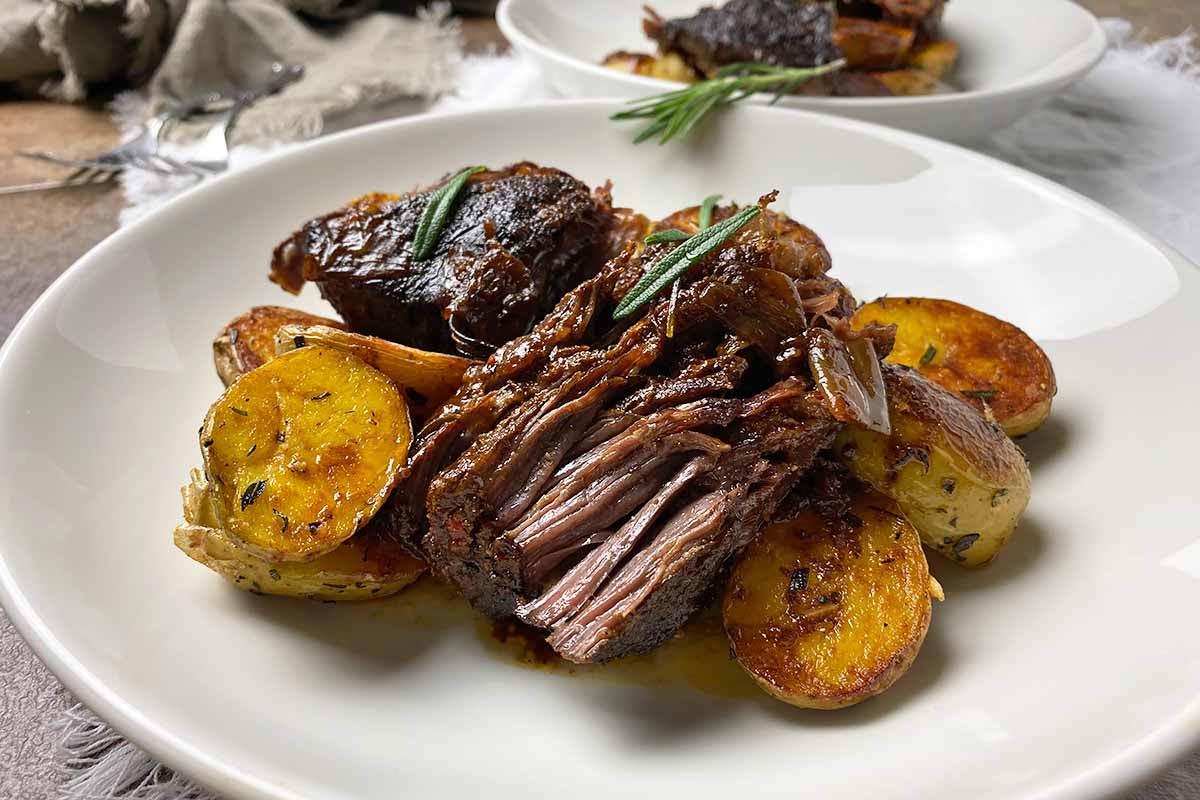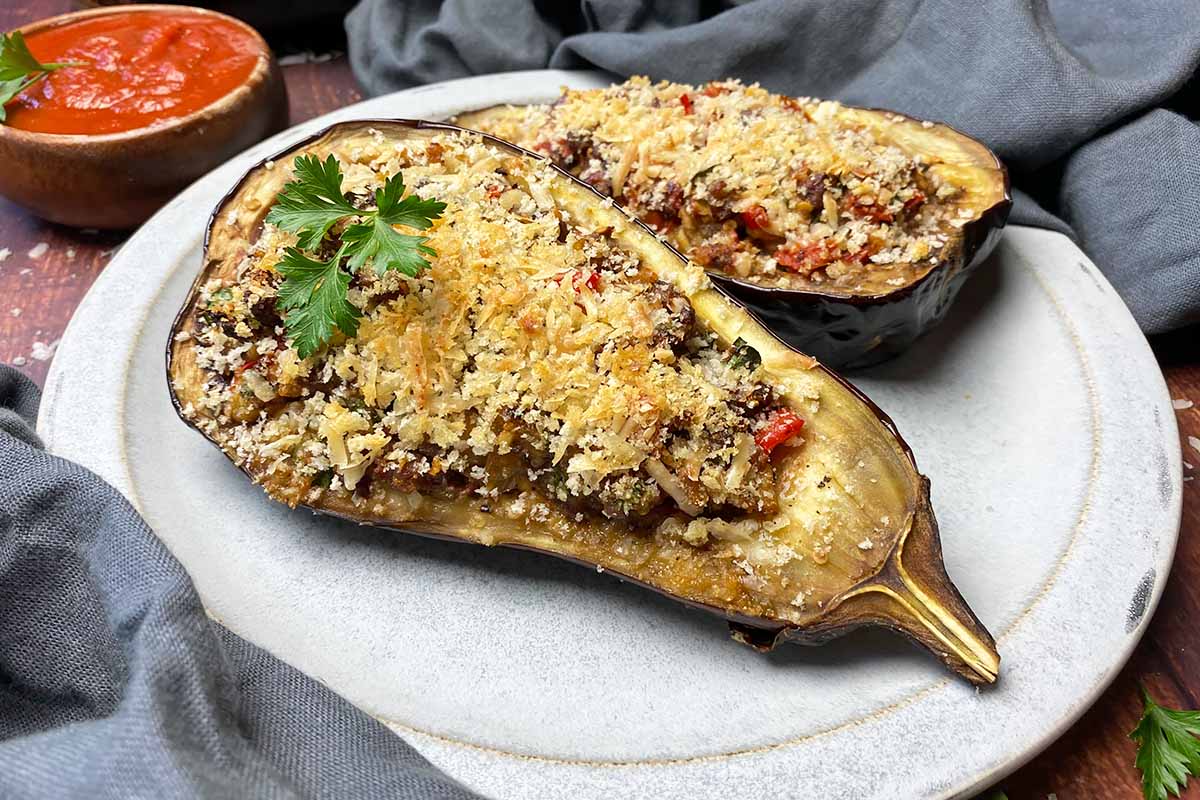Cooking like a peasant is completely underrated. And I mean that in the most complimentary of ways.
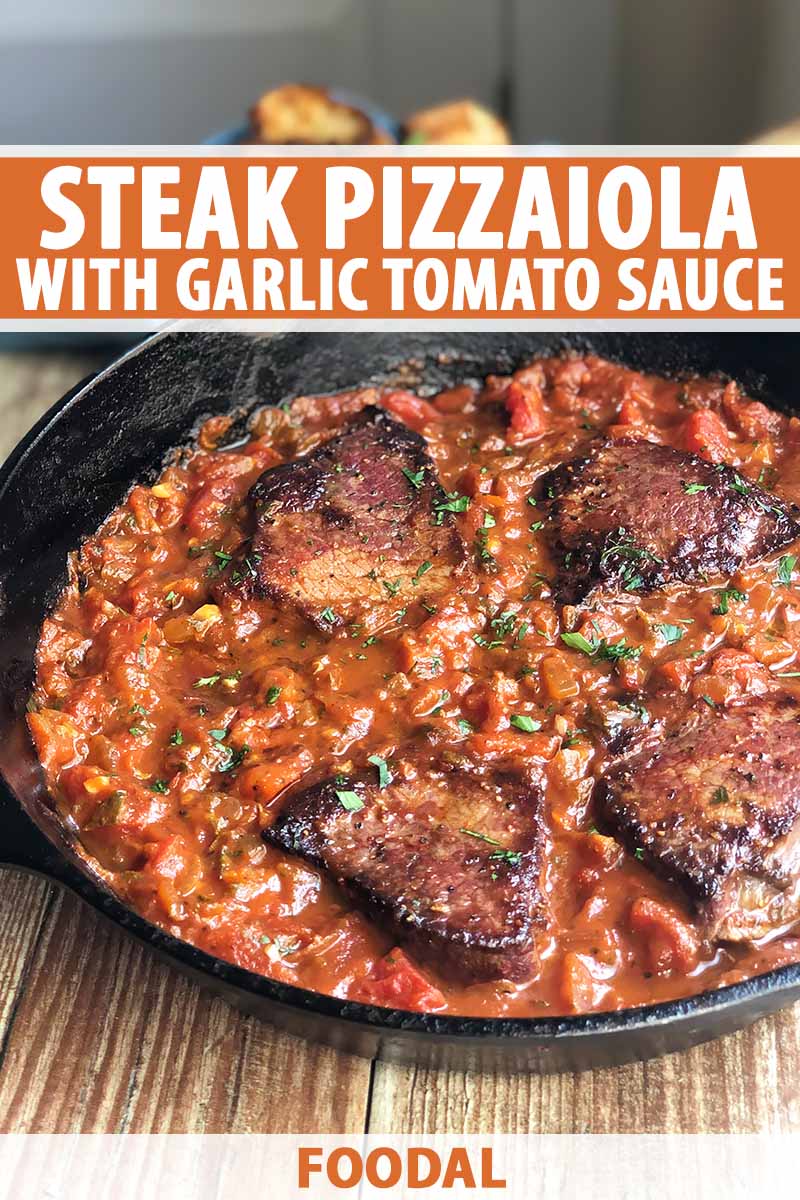
Aren’t most of us just throwing together what we have on hand half of the time anyway? If you’re unfamiliar with the notion of peasant cooking, pull up a piece of Parmesan and listen up.
A simple expression of culinary scraps (whatever you find in your pantry, fridge, or farm) blended together to create a meal is essentially the gist. There’s a genius behind this rustic way of cooking and eating, and it all stems from the theory of a no-waste kitchen.
And when it comes to making a little go a long way, look no further than steak pizzaiola.
No, it’s not a steak pizza. Although those are bomb too.
This classic Neapolitan-rooted dish that comes together in way under an hour is a medley of meat, aromatics (garlic, onions, and herbs), and tomatoes.
As my friend Ina Garten would say, “How bad could it be?”
Just kidding. We’re not friends. She hasn’t returned my calls in months.

Creating a delicious feast in this “using what you’ve got” fashion is a concept woven through past societies in various cultures, and steak pizzaiola is one of many Italian versions of this approach.
In Italy, post-war conditions forced much of the lower-class to take advantage of what was available. From there, traditional old-school dishes like white bean stew or day-old bread topped with tomatoes and basil were born.
Also known as carne alla pizzaiola, which translates to “meat, pizza style,” steak pizzaiola begins with cheap cuts of meat simmered in a bright, rich sauce loaded with aromatics.
Authentically the meat was, of course, dependent on accessibility, but sirloin was often the star. Strip, tenderloin, flank, or round steak are also commonly used today, and are often either thinly sliced or pounded flat.
I prefer using a thicker portion since the steak goes through two rounds of heat, being seared and then simmered to warm back through.
It’s all about affordability, and the beauty of steak pizzaiola is extracting everything you can out of simple ingredients like leftover pizza sauce, a cheap cut of meat, and a crusty baguette.
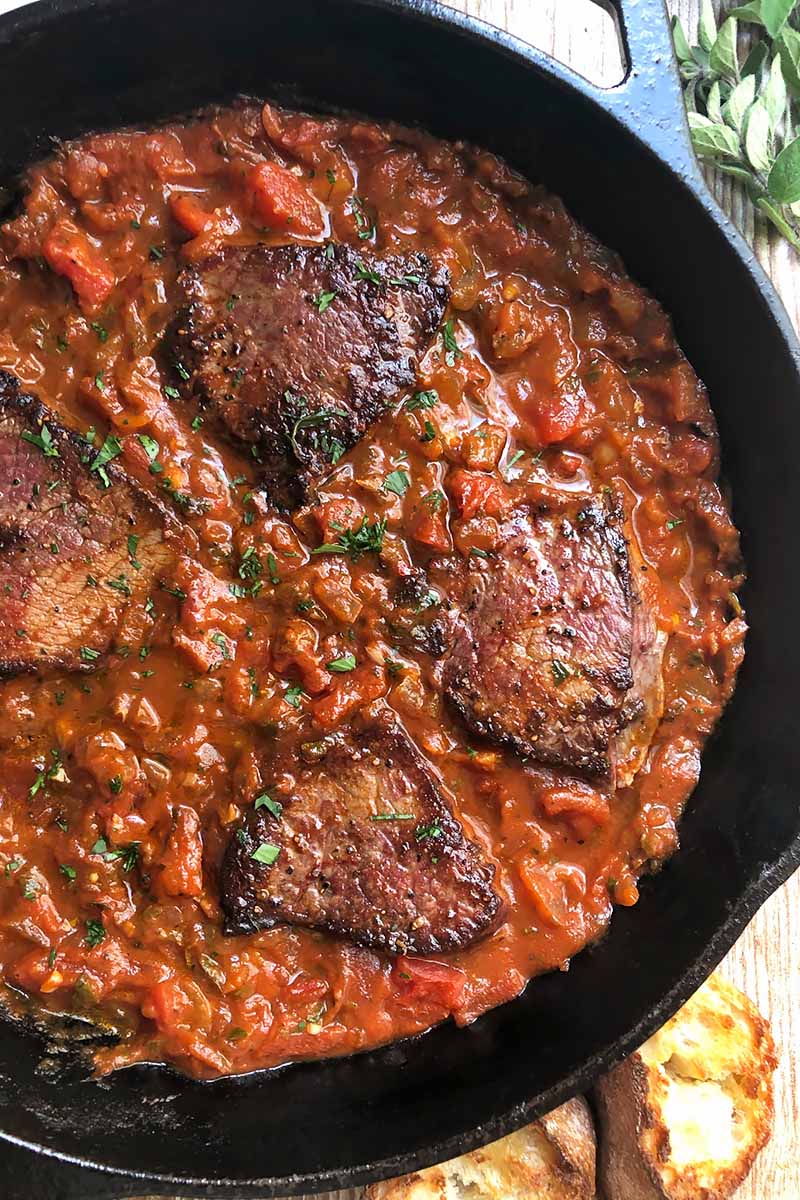
If tomatoes aren’t in season and you don’t already have a can laying around, snag some San Marzanos which are famed for their sweetness, balanced flavor, and low acidity. Trust me. They are worth the few extra bucks.
We both know you have dried oregano in that spice rack, so feel free to use that at about one-third the quantity of the fresh (and add it in along with the red pepper flakes towards the beginning).
Since this recipe consists of protein and sauce, allowing a carb to join your table is the best practice towards becoming a member of the Clean Plate Club. You can trust me on this one, too. I’m the Secretary of Spilling on my shirt, and my dad is the VP.
I always keep portioned-out pieces of hearty Italian loaves in my freezer for last-minute garlic bread – and I like to save the individually torn baguettes that come alongside soups and salads at most cafes – but polenta or noodles work just fine for sauce-sopping.
Steak pizzaiola requires no fancy finessing, just an enthusiastic zest for eating, and a healthy romanticization of the idea of making the most of what’s around.
Hard to say no to that, right?
Print
Steak Pizzaiola
- Total Time: 35 minutes
- Yield: 4 servings 1x
Description
Welcome steak into your weeknight dinner roundup with this rustic recipe where tender beef gets simmered in a garlicky tomato sauce.
Ingredients
- 4 boneless sirloin steaks about 1 inch thick, (about 1 1/4 pounds, or use another tender cut such as flank or round steak)
- 1 1/2 teaspoons coarse salt, divided
- 1/2 teaspoon freshly ground black pepper
- 2 tablespoons olive oil, divided
- 1/2 cup diced yellow onion (about 1 small)
- 1 pinch crushed red pepper flakes
- 2 large cloves garlic, minced
- 1/4 cup dry white wine (optional, or see below for substitutions)
- 1 28-ounce can diced tomatoes
- 1 tablespoon chopped fresh oregano
- 2 tablespoons roughly chopped fresh parsley
Instructions
- Pat the steaks dry and then season them on both sides with 1 teaspoon of the salt and the pepper.
- In a large skillet over medium-high heat, add 1 tablespoon of the olive oil and swirl to coat the pan.
- Once the oil is shimmering, add the steaks and sear until a golden-brown crust has formed, about 2 minutes on the first side and 1 minute on the second. Transfer the steaks to a plate and reduce the heat to medium.
- Add the remaining tablespoon of olive oil to the pan, and swirl to coat. Add the onion and red pepper flakes. Sweat the onions, stirring occasionally until they have softened, about 3 minutes.
- Add the garlic. Cook for 1 more minute, and then deglaze the pan with the white wine or your choice of alternative, scraping up any brown bits from the bottom. Pour in the tomatoes, remaining 1/2 teaspoon salt, and the oregano. Stir to combine.
- Bring the sauce to a simmer and cook for 10 minutes. Add the steaks (along with their juices) back to the skillet and cook until they’re warmed back through, about 3 more minutes.
- Evenly divide the steaks and sauce among plates, garnish with the parsley, and serve with slices of a crusty toasted baguette or focaccia for sopping up sauce.
Notes
Prefer not to cook with white wine, or you don’t have any on hand? No problem! You could also substitute red wine, or even a splash of balsamic vinegar, either regular or white. Beef or chicken broth also add a nice savory flavor, or a glug of water can work in a pinch.
- Prep Time: 10 minutes
- Cook Time: 25 minutes
- Category: Beef
- Method: Stovetop
- Cuisine: Dinner
Keywords: steak, Italian, tomato
Cooking By the Numbers…
Step 1 – Prep the Veggies and Herbs, and Sear the Steaks
Dice the onion, mince the garlic, and chop the oregano and parsley.
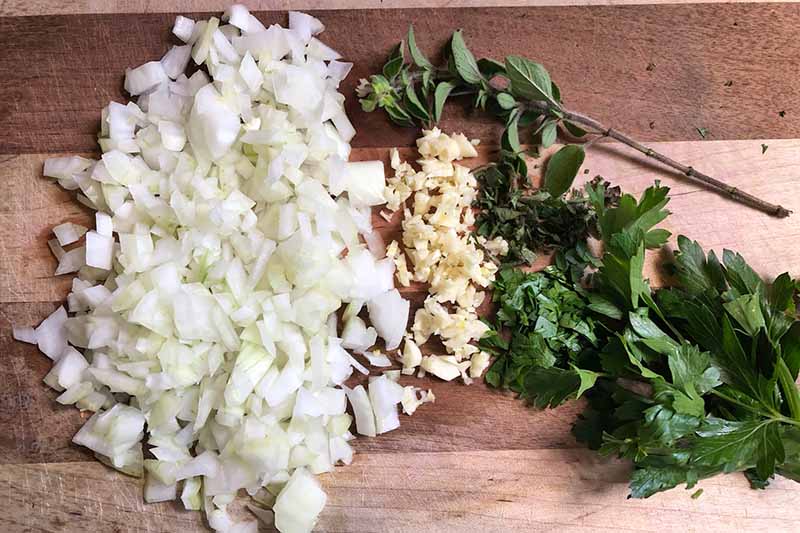
Only have dried herbs on hand? That’s okay! Remember to add the oregano, and parsley if you like, along with the red pepper flakes in Step 2. Skip the final garnish.
Blot the steaks dry with paper towels, and then season them on both sides with 1 teaspoon of the salt, and the freshly ground black pepper. Drying the steaks helps to ensure a golden-brown crust on the meat, whereas excess moisture inhibits browning.
In a large skillet over medium-high heat, add 1 tablespoon of the olive oil and swirl to coat the pan.
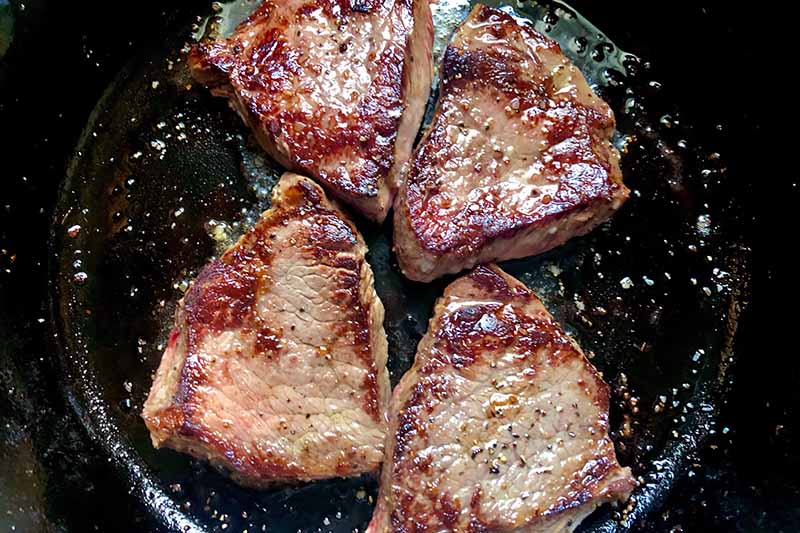
Keep an eye on things, because you don’t want the oil to get too hot and start smoking. Once the oil is shimmering, add the steaks and sear them until a golden-brown crust has formed. This should take about 2 minutes on the first side, and 1 minute on the second after you flip them.
Transfer the steaks to a plate, and reduce the heat to medium.
Step 2 – Sweat the Onions and Build the Sauce
Add the remaining tablespoon of olive oil to the pan, and then the onion and red pepper flakes. (This is where you can add your dried herbs if you’re using them as well).

Sweat the onions, stirring occasionally until they have softened and turned translucent. This will take about 3 minutes.
Add the garlic, stir, and cook for about 1 more minute, until it is fragrant. You don’t want it to burn!
Deglaze the pan with the white wine (or your choice of alternative), scraping up any brown bits from the bottom of the pan, aka fond.
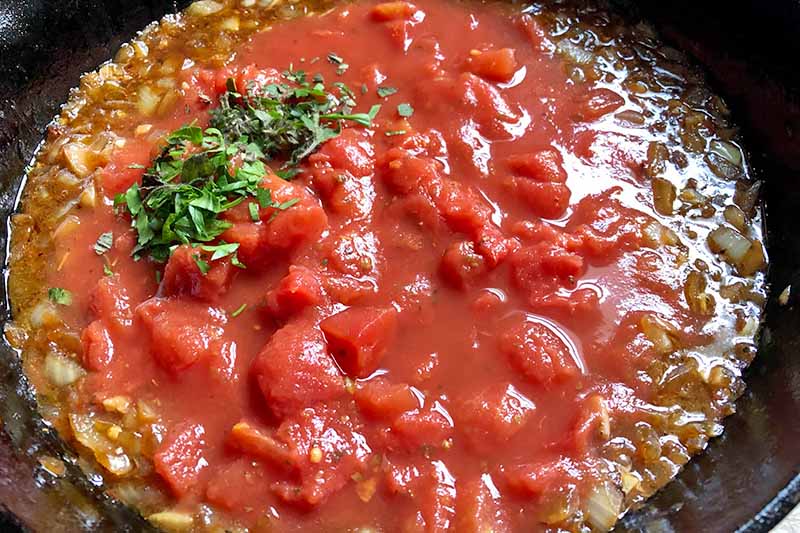
Pour in the tomatoes, the remaining 1/2 teaspoon salt, and the oregano if you are using fresh herbs. Stir to combine.
White wine gives the sauce a refreshing brightness, but you could substitute red wine or even a splash of balsamic vinegar (if you prefer not to use wine) for a richer, more robust flavor. Any variety of stock, either homemade or store-bought low sodium, can also be used.
Step 3 – Simmer the Sauce
Bring the sauce to a simmer and cook for 10 minutes.
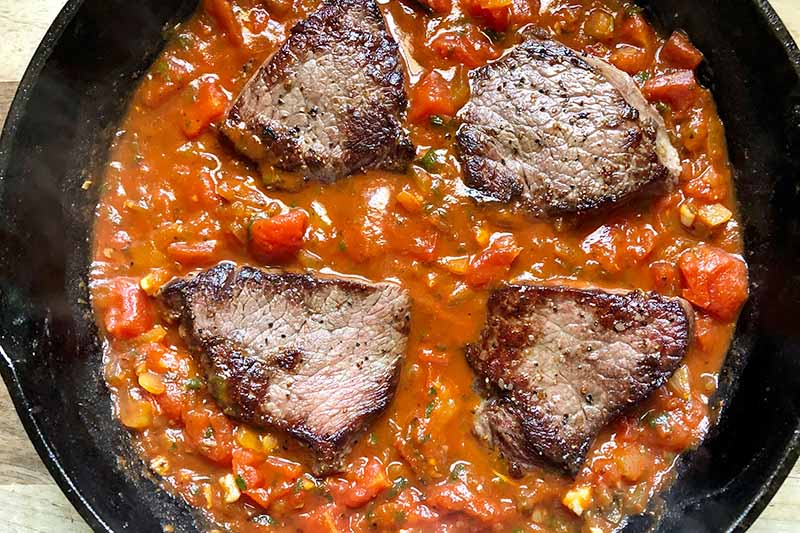
Add the steaks (along with their juices) back to the skillet. Cook until they’re warmed back through again, for about 3 minutes or so.
If you’re using thinner cuts of meat, only warm them through for about 1 minute, so they don’t overcook.
Step 4 – Garnish and Serve
A crusty baguette or focaccia makes a great vehicle for sopping up the sauce from this dish, so if you’re using bread, now would be the time to warm it up or toast it.
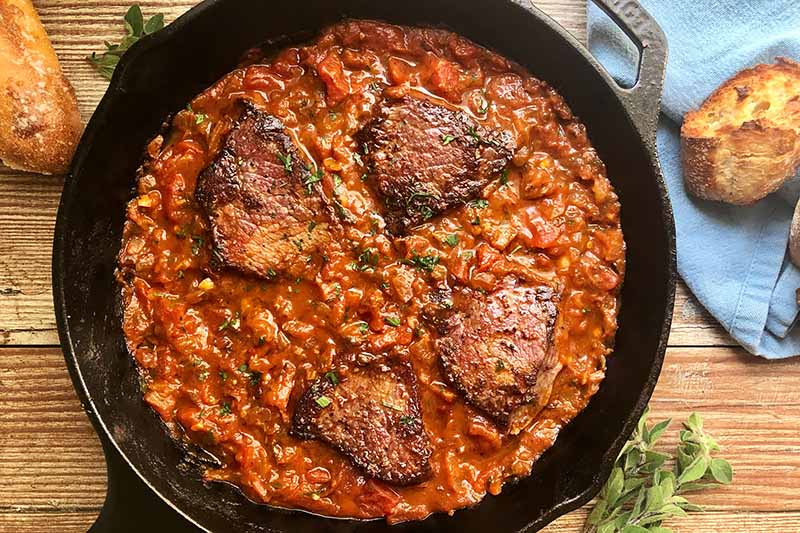
Evenly divide the steaks and sauce among plates, garnish with the parsley, and serve with bread on the side.
All Hail the One-Pan Entree
Always keep an eye out for tender cuts of meat whose costs have been slashed, thanks to holiday sales or excess quantities at the store. Stock up, portion out, and freeze.
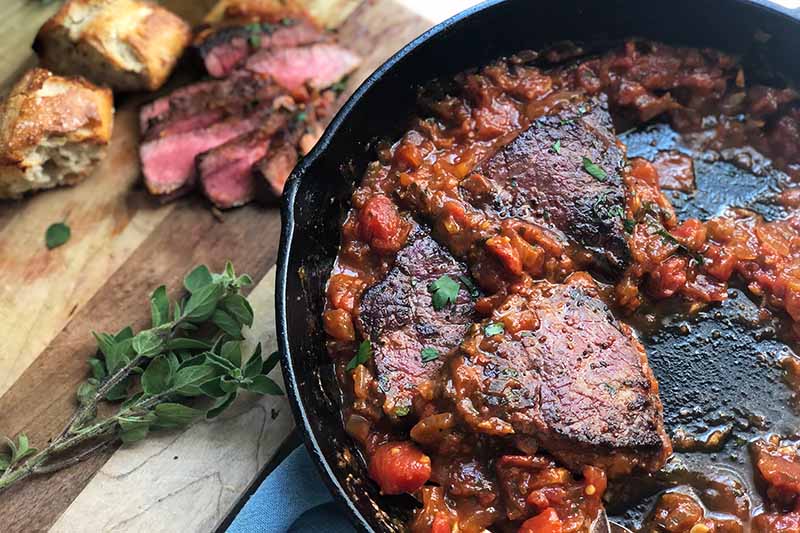
The next time you’re staring aimlessly into your pantry at 5 p.m., you’ll think of me when you remember you’ve got flank steaks in the freezer, and canned tomatoes somewhere behind the peanut butter. Frozen tomato concasse from a fresh batch of overstock produce makes a lovely addition to this dish as well.
Steak pizzaiola, here you come!
Recipes that are meant to stretch what you have on hand are the ones you’ll come back to time and time again, and those that only require one pan to prepare make the whole cooking (and cleaning) experience that much sweeter.
Want even more tasty dishes that come together in a single vessel? Of course you do. Give these good eats a spin next:
Ready for the most legit steak and eggs experience you’ll ever have? When you’re putting those steaks back into the sauce to warm through at brunch-o’clock, or if you’re craving breakfast for dinner, create a couple wells, crack in some eggs, and simmer (with the pan covered) until the whites are set. Buon appetito!
How will you perk up your pizzaiola? Share your tricks in the comments below! And don’t forget to give this recipe a five-star rating if you loved it.
Photos by Fanny Slater, © Ask the Experts, LLC. ALL RIGHTS RESERVED. See our TOS for more details. Originally published on February 7, 2011. Last updated on July 1, 2021.
Nutritional information derived from a database of known generic and branded foods and ingredients and was not compiled by a registered dietitian or submitted for lab testing. It should be viewed as an approximation.
About Fanny Slater
Fanny Slater is a home-taught food enthusiast based in Wilmington, North Carolina who won the “Rachael Ray Show” Great American Cookbook Competition in 2014, and published her cookbook “Orange, Lavender & Figs” in 2016. Fanny is a food and beverage writer, recipe developer, and social media influencer. She was a co-host on the Food Network series “Kitchen Sink,” was featured on Cooking Channel’s longtime popular series “The Best Thing I Ever Ate,” and continues to appear regularly on the “Rachael Ray Show.”


